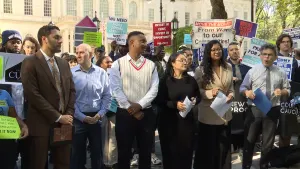More Stories
Despite months of vaccination campaigns to target vulnerable communities, data shows that Black and brown New Yorkers are still not getting vaccinated as much as the rest of the community.
Pop-up vaccination sites have been set up in communities of color throughout the city to get more Black and brown people vaccinated. Still, according to city data, less than 25% of Black New Yorkers in the Bronx and Brooklyn are fully vaccinated.
City data shows that Black and Latino communities have suffered the most from COVID-19.
Some local organizations say it's a barrier to access, which is why local governments and New York Health & Hospitals have targeted efforts toward these groups through campaigns and easily accessible vaccine sites like train stations and Yankee Stadium.
The CDC reported less than a quarter of Black Americans nationwide received their first COVID-19 shot. In the Bronx, 38% of white people and 45% of Asian and Pacific Islander adults received their vaccine.
But Black adults are still the lowest vaccinated racial group in all of New York City, while white adults and Asian adults are showing the highest vaccination rates.
Community groups in the Bronx say the problem is a mistrust of the government that goes far beyond COVID-19.
"A lot of the times when you go to a hospital in the Black community what tends to happen is the treatment is not the same as in other communities. I think that's where the mistrust also occurs. You hear about things that are happening in poor communities and that's allowed to happen, you don't have trust in government when it comes to minorities," said Julie Spitzer of Bronxworks.
That mistrust has a long history. Spitzer shared with News 12 that when she speaks to members of the Black community who are skeptical of the vaccine, they often bring up the Tuskegee experiment -- a racist study conducted by the CDC in the 1930s that used Black men as test subjects to study syphilis without their consent.
Spitzer says that bettering the relationship between Black and brown communities and the health care system may just take time.
More from News 12
2:34

Guide: Safety tips to help prevent home burglaries
2:19

Guide: Safety measures to help prevent fires and how to escape one
2:40

Mayor's budget cuts: A controversial solution amidst immigration crisis
2:07

Tips on how to avoid confrontation with sharks while swimming in the ocean
2:33

5 tips to prevent mosquito bites and getting sick from viruses
2:39
